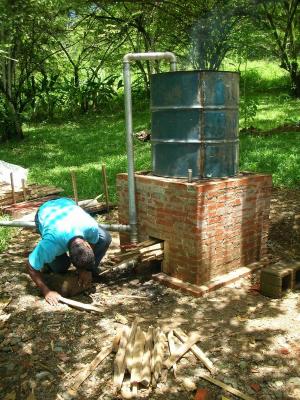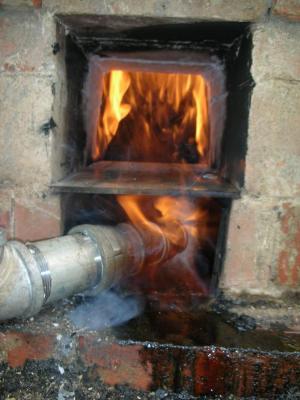Rockin Rocket Retort
- Log in to post comments
Rob Lerner, May, 2010
From Rob's Biochar Blog: http://biocharlog.blogspot.com/
Also take a look at his Captioned Slideshow: http://picasaweb.google.com/bajarob/RockinRocketRetort#.
Yesterday was the christening of my new kiln, the Rocket Retort, a culmination of many months of research, design, contemplation; and a recent spate of hard work. Like so many others bit by the biochar bug, I wanted to create a kiln for my own use. I also recognized the potential that a practical, high-performance, "personal" biochar kiln could have in leveraging distributed production among home gardeners and other small stakeholders, and perhaps ultimately, subsistence farmers worldwide. My prior experience of small biochar kilns, gleaned from YouTube profiles and my own backyard pyrotechnics, had been of barely-contained conflagrations that produced an uncertain sort of biochar. My Rocket Retort design was informed by my work as hardware development manager for a philanthropic-funded biochar project in Costa Rica, involving a much larger kiln designed by Nikolaus Foidl and guided by Stephen Joseph, two of biochar's leading lights. Design criteria for my personal kiln include:
* Low cost materials
* Basic shop tools only
* Low emissions
* Efficient biomass conversion
* Controlled firing profile
* Recycle pyrolysis gases
* Collect wood vinegar
The other design consideration was collecting wood vinegar (natural pesticide and plant growth stimulant) and recycling pyrolysis gases. A two-inch steel pipe was threaded onto the bung hole on the lid of the retort drum, exiting holes cut into the shallow cone lids, and elbowing down toward the stove's fuel feed opening. A "T" fitting and valves enable directing evolved gases toward either a condenser pipe leading away from the kiln to collect wood vinegar, or directly into the fuel chamber to fire the kiln. The fuel feed opening is divided horizontally by a stainless plate, with the lower portion intended for intake air. Being able to block the throat of the upper portion of the feed chamber enables greater range of control and can improve combustion efficiency by limiting excess air.
We were thrilled with our first firing! The rocket stove enables ramping up temperatures gradually, which could be a big advantage when working with high moisture content feedstocks. The cross-over from distillation to pyrolysis was fairly tender. Directing all of the gasses into the stove's fuel chamber resulted at first in an over-temperature condition, which was alleviated by diverting pyrolysis gasses out the vinegar condenser pipe--at one point flames were shooting out two meters (very dramatic!)--stimulating conversation on the various uses to which these surplus combustible gasses could be put.
For future firings the kiln will be fitted with thermocouples and a multi-station digital thermometer so we can approach pyrolysis temperatures a bit more gingerly, with the goal of achieving a longer soak at the lower end of the pyrolysis range to retain more organic compounds in the carbon matrix for a more plant-effective biochar. Separately, I'm working on a design for a rotisserie-style reactor for making biochar mineral complex (BMC)--a step up from garden variety biochar. Wood biochar, clay, chicken litter, and mineral nutrients (rock phosphate, calcium, etc.) will be blended and loaded into a 55 gallon drum mounted laterally over the rocket stove for tumble-heating at sub-pyrolysis temperatures, to create a substance resembling aged terra preta (based on the pioneering work of Stephen Joseph).
It is worth noting that labor was not among my design considerations. Although labor cost is crucial in commercial economic analysis, home gardeners are known to lavish lots of time on their gardens, heedless of return on their labors. Likewise, backyard biocharers generally do it for the benefit of their garden and for sport (the thrill of the burn). As for the ultimate target audience, subsistence farmers, the low-value of their labor is one of the snares of the poverty trap. Producing biochar, and improving the productivity of their agriculture, might just help them pick the lock.
For a captioned slideshow, go to: Rockin' Rocket Retort. We'll get a YouTube together soon.trace affiliate link | Nike News


